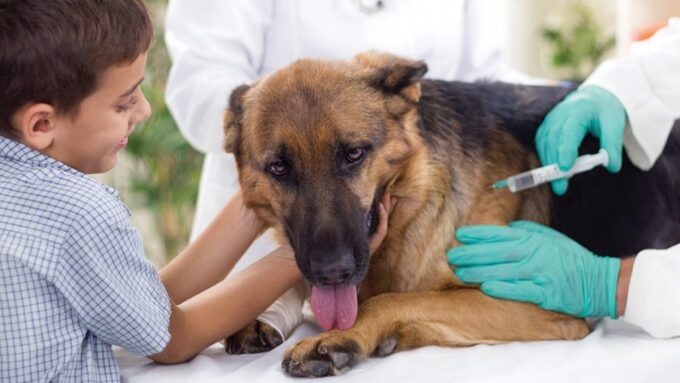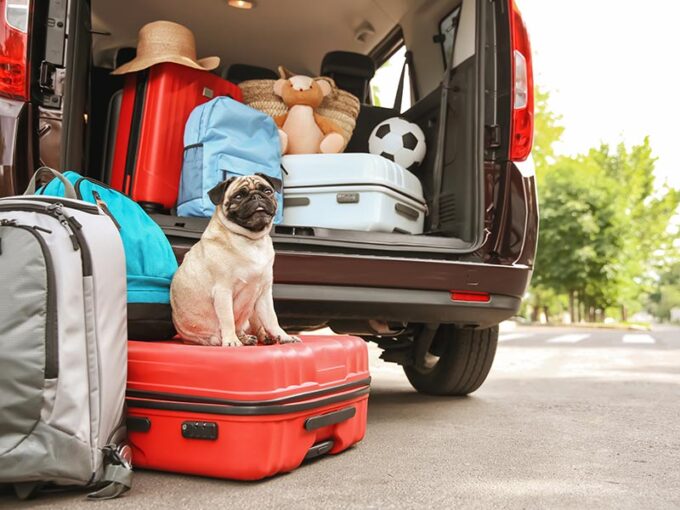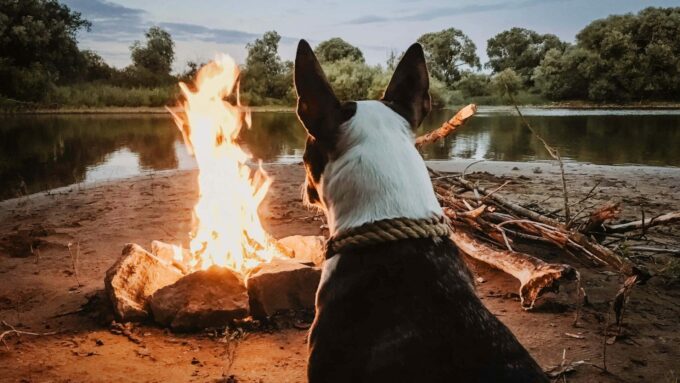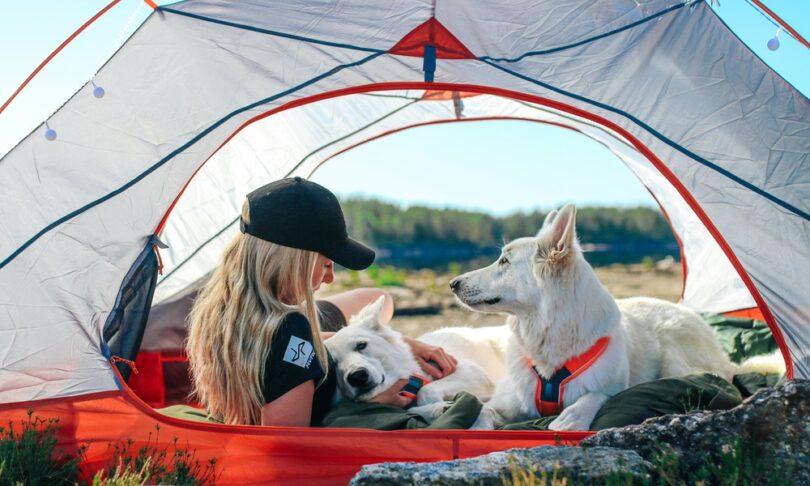Many dog owners love to take their pets vacationing with them, and going camping is an extremely popular choice.
But before you pack your tent or RV and hit the road, here are some essential tips and advice on camping with your dog for the first time.
1.Are Dogs Permitted on The Campground?
There’s nothing worse than arriving at your chosen campground to discover that they don’t allow dogs. So, before you set off, double-check with the campsite that they are dog friendly.
You can learn how to find a suitable accommodation for your camping vacation in the article.
2. What Are the Campground Rules?
Even dog-friendly campsites have rules that all their guests are expected to follow. Make sure you know what’s expected of you and your dog before you get there.

Source: dogtime.com
Vaccinations
You must have your dog’s vaccinations up to date to be allowed on most campgrounds. Your furry friend must also wear a collar with his rabies and ID tags clearly displayed.
Aggressive Dogs
If you have an aggressive dog that’s antisocial toward other dogs and strangers, no campground will welcome you.
Leash rules
Pretty much every dog-friendly campground asks that visitors keep their pets under full control and always leashed. Also, many sites insist that the leash is shorter than six feet, and spring-back retractable leashes are not allowed.
Crates
Most campgrounds require your dog to be crated or tethered when you’re not around to watch him.
According to Fivebarks.com, a soft, portable dog crate is ideal for a vacationing dog. Soft crates are collapsible, warm, and comfortable, providing the ideal convenient holiday home for your dog.
Barking
Most dogs do bark, especially when in a strange environment. However, most campgrounds won’t tolerate excessive barking, especially at night. If your dog is an out-of-control barker, you might be asked to leave!
2. Safety
Your dog’s safety should be paramount for his first camping trip. Here are a few essential considerations to bear in mind before you go:

Source: firelightcamps.com
Ticks and Fleas
Unfortunately, ticks and fleas are all too abundant on hiking trails, especially if you head to a wilderness campground to enjoy a vacation in the Great Outdoors.
Ensure that your dog is treated with a flea and tick prevention medication before you leave so that you don’t come home with a few unwanted hitchhikers!
Microchipping
Most US campgrounds don’t insist on microchipping, but we do recommend that you have your dog chipped before you take him on vacation with you. If your dog escapes or runs off and gets lost, a microchip can ensure that you and your Houdini hound are quickly reunited.
Emergency Contact Information
Accidents do sometimes happen, and you need to be prepared, just in case your dog has a mishap and gets sick or is injured.
Check out the area around your chosen campground and make a note of veterinary services close by. Pack your dog’s medical records so that the local vet has access to all the information he needs if your pet requires treatment.
3. What to Pack for Your Dog
When camping with your dog, there are some essential supplies that you’ll need to take with you, including:

Source: akc.org
- Dog food
- Treats
- Food and water bowls
- Prescription medicines if required
- Collar, harness and leash
- ID and rabies vaccination tags
- Tether
- Towels
- Dog first aid kit
- Medical information including vaccination record
- Poop bags
- Dog bed
- Crate
We recommend keeping your dog’s possessions in a plastic box or bag so that nothing gets misplaced.
4. Practice Makes Perfect
If you’ve never taken your dog camping before, it’s essential that you have a practice run before you go.
First, make sure that your dog is obedient to basic commands and is well-mannered on his leash. There are bound to be other dogs around on the trails and in the campground, so ensure that your pooch is well-socialized. It’s a good idea to go on a few playdates with other pups or perhaps attend obedience training classes for the weeks leading up to your vacation.
You might also want to set up a campground in your backyard and have a trial run. Have your dog tied up, crated, or always leashed, invite some friends to come for a cookout, and enjoy an evening sitting in front of a campfire.
Observe your dog closely. Is your furry friend confused by the lack of freedom? Does he appear upset or distressed? Does your dog bark incessantly? If your dog is stressed or anxious around other people, you might need to consider a different type of vacation.
5. At the Campground
At the campground, take note of these important points:

Source: goget.com.au
Do Not Leave Your Dog Unattended!
Never leave your dog unattended on a camping trip. That goes for when you’re at the campground, at dog parks, in your RV or car, and during activities. The unfamiliar lack of freedom will stress your pet
Remember that your dog is in a strange place, possibly surrounded by unfamiliar sights and sounds. Don’t abandon your furry friend! Keep your dog happy and relaxed by making sure you always stay with him.
Bring Lots of Dog Toys
Most dogs have lots of toys to play with at home. Even though you will probably be spending a lot of time hiking, boating, or taking part in other exciting activities with your dog, he will still appreciate a reminder of familiarity and home. So, pack a few of your pet’s favorite toys and play with him for a little while each day.
Don’t Forget to Give Your Dog Plenty of Water
Dehydration can be a serious health problem for dogs on vacation, especially during an active day when the weather is very warm. Read more about protecting your dog from the effects of dehydration at this link.
Did you know that an adult dog needs around one ounce of water per pound of his bodyweight every day? So, be sure to take a collapsible bowl with you on the trails, and always have water available for your dog at the campground.
Top up your dog’s water dish with clean water regularly and keep the water in a shady place where the water gets warm or evaporate.
Secure Your Dog
Remember that most campsites request that dogs are tethered, crated, or leashed while on the site.
Wildlife Warning
If you’re taking your vacation in a wilderness area, it’s inevitable that you’ll meet unfamiliar plants and animals at some point in your trip.
Keep your dog on his leash and avoid areas where ground-nesting birds could be hiding. Snakes are a possible hazard in some areas, and some plants can be toxic to dogs, too. Blue-green algae is extremely hazardous to dogs. So, don’t allow your dog to swim in ponds or drink water from puddles, especially if you can see blue-green algae growing.
6. Plan Ahead

Source: nerdynaut.com
You can help your vacation to go smoothly by planning some dog-friendly activities in advance.
A few fun things that you can do with your dog include:
- Kayaking or sailboat trips
- Beach walks
- Eating at dog-friendly bars and restaurants
- Checking out dog parks
It’s well worth researching and planning in advance, as not everywhere welcomes dogs. In fact, many state parks and beaches not open to dogs during the holiday season.
Final Thoughts
A camping vacation can be the ideal getaway choice for you if you want to take your canine companion with you.
Choose a dog-friendly campground, brush up on your dog’s obedience training, ensure that your dog is well-socialized, and get ready to hit the road for a fun-filled family vacation together with your four-legged furry friend!







